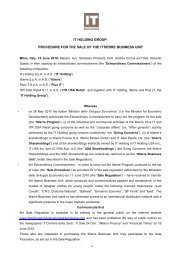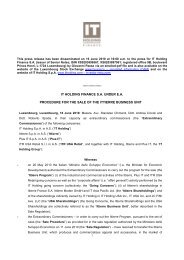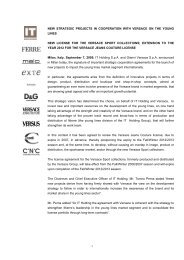You also want an ePaper? Increase the reach of your titles
YUMPU automatically turns print PDFs into web optimized ePapers that Google loves.
<strong>IT</strong> HOLDING S.p.A. Notes to the consolidated financial statements for the year ended December 31, 2004<br />
Derivative financial instruments<br />
Derivative financial instruments are used by the <strong>IT</strong> HOLDING Group solely for the purpose of hedging interest<br />
rate risk and currency exposure arising from operations. In accordance with its treasury policy, the Group does not<br />
hold or issue derivative financial instruments for trading or speculative purposes. However, derivatives that do not<br />
qualify for hedge accounting are accounted for as trading instruments.<br />
Derivative financial assets and liabilities are stated at fair value and are classified in the balance sheet, respectively<br />
as other current assets and other current liabilities.<br />
The market value of Interest rate swaps reflects the present value difference between the fixed rate to be<br />
paid/received and the interest rate assessed on the basis of the market trend having the same expiry date as the<br />
swap. The fair value of forward exchange contracts and currency options is estimated by reputable financial<br />
institutions on the basis of market conditions. The counterparties to derivative contracts are generally highly rated<br />
banks and financial institutions in order to minimize the risk of non-performance.<br />
Cash flow hedges<br />
Changes in fair values of derivatives that are designated and qualify as Cash flow hedges and that are highly<br />
effective are deferred in the equity account, “Hedging reserve”. Amounts deferred in the “Hedging reserve” and<br />
any subsequent changes in the value of these derivatives are recorded in the income statement in the same period<br />
and classified in the same income statement accounts as the related hedged transactions.<br />
Foreign exchange exposure<br />
The Group does not consider cost effective the requirements of IAS 39 for the use of hedge accounting in relation<br />
to the hedge of foreign exchange risk. Derivative financial instruments used to hedge foreign exchange exposure<br />
of a forecasted transaction (or Group of transactions) or of a recognised monetary asset or liability, are accounted<br />
for at fair value and the change in fair value recognised in the income statement.<br />
Non derivative financial assets<br />
The Group’s non-derivative financial assets are comprised of loans and receivables and hence are non-derivative<br />
financial assets with fixed or determinable payments that are not quoted in an active market. They are initially<br />
measured at cost which approximates fair value and subsequently measured at amortised cost using the effective<br />
interest method.<br />
Trade receivables are classified as a separate line item in the balance sheet whereas other non-derivative financial<br />
assets are classified as short-term financial assets and long-term financial assets.<br />
Trade receivables<br />
Trade receivables are initially stated at cost which approximates their fair value. Subsequently they are measured<br />
at amortized cost less provision for impairment.<br />
Securitization programme<br />
In July 2003, the Company, along with certain subsidiaries entered into a securitization programme with certain<br />
Crédit Lyonnais Group companies for the securitization of trade receivables. Trade receivables that satisfy<br />
specified selection criteria are transferred by the subsidiaries on a monthly basis and a securitization fee being a<br />
discount of 2.5% on receivables transferred, is charged. Group subsidiaries, under a servicing agreement, remain<br />
responsible for the collection of these receivables. Against the receivables acquired, the transferee issues senior<br />
notes placed on the market and junior notes that are subscribed by the Company. The number of junior notes<br />
issued is calculated as a percentage of total receivables. The junior notes are issued and subscribed on a monthly<br />
basis, however the repayment of principal and interest on these notes is subordinated to the prior repayment of<br />
principal and interest on the senior notes. The yield on the junior notes is determined by reimbursing the 2.5%<br />
discount on receivables transferred that have been successfully collected and by deducting interest accrued on net<br />
consideration received and losses incurred on receivables transferred. The mechanism of the junior notes maintains<br />
substantially all the risks and rewards linked to the receivables transferred, within the Group as it is highly<br />
F- 13






